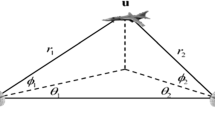Abstract
This paper addresses the problem of target localization using angle-of-arrival (AOA) measurements when the prior information of the AOA measurement noise variance is unavailable. At first, a maximum likelihood estimator (MLE) and the Cramér–Rao lower bound are derived for the case where the unknown noise variance is a function of the target-to-sensor distance. Then, a novel estimator is proposed to obtain a closed-form solution without the knowledge of noise variance. The proposed estimator can efficiently improve the localization performance by fully exploiting the desirable advantages of the instrumental variable (IV) method and the set of generalized pseudolinear equation. The simulation results show the superior performance of the proposed estimator compared with the MLE, the IV estimator and the pseudolinear estimator.







Similar content being viewed by others
Data Availability Statement
The datasets generated and analyzed during the current study are available from the corresponding author on reasonable request.
References
L. Badriasl, S. Arulampalam, A. Finn, A novel batch Bayesian WIV estimator for three-dimensional TMA using bearing and elevation measurements. IEEE Trans. Signal Process. 66(4), 1023–1036 (2018)
R.J. Bowden, D.A. Turkington, Instrumental Variables (Cambridge Univ. Press, New York, 1984)
K. Doğançay, Bias compensation for the bearings-only pseudolinear target track estimator. IEEE Trans. Signal Process. 54(1), 59–68 (2006)
K. Doğançay, Passive emitter localization using weighted instrumental variables. Signal Process. 84, 487–497 (2004)
K. Doğançay, Bearings-only target localization using total least squares. Signal Process. 85, 1695–1710 (2005)
W.H. Foy, Position-location solutions by Taylor-series estimation. IEEE Trans. Aerosp. Electron. Syst. 2, 187–194 (1976)
S. Haykin, Adaptive Filter Theory, 3rd edn. (Prentice-Hall, Englewood Cliffs, 1996)
B. Huang, L. Xie, Z. Yang, TDOA-based source localization with distance-dependent noises. IEEE Trans. Wirel. Commun. 14(1), 468–480 (2015)
S.M. Kay, Fundamentals of Statistical Signal Processing (Prentice Hall PTR, Upper Saddle River, NJ, 1993)
M.G. Kendall, A. Stuart, The Advanced Theory of Statistics, vol. 2 (Griffin, London, 1961)
Y. Liang, Yingmin Jia, Constrained optimal placements of heterogeneous range/bearing/RSS sensor networks for source localization with distance-dependent noise. IEEE Geosci. Remote Sens. Lett. 13(11), 1611–1615 (2016)
A.G. Lingren, K.F. Gong, Position and velocity estimation via bearing observations. IEEE Trans. Aerosp. Electron. Syst. 4, 564–577 (1978)
L. Ljung, T. Söderström, Theory and Practice of Recursive Identification (MIT Press, Cambridge, 1983)
H. Lohrasbipeydeh, T.A. Gulliver, H. Amindavar, A minimax SDP method for energy based source localization with unknown transmit power. IEEE Wirel. Commun. Lett. 3(4), 433–436 (2014)
S. Nardone, A. Lindgren, K. Gong, Fundamental properties and performance of conventional bearings-only target motion analysis. IEEE Trans. Autom. Control 29(9), 775–787 (1984)
J.A. Nelder, R. Mead, A simplex method for function minimization. Comput. J. 7, 308–313 (1965)
N.H. Nguyen, K. Doğançay, Closed-form algebraic solutions for angle-of-arrival source localization with Bayesian priors. IEEE Trans. Wirel. Commun. 18(8), 3827–3842 (2019)
N.H. Nguyen, K. Doğançay, E.E. Kuruoğlu, An iteratively reweighted instrumental-variable estimator for robust 3-D AOA localization in impulsive noise. IEEE Trans. Signal Process. 67(18), 6524–6535 (2019)
F. Pang, K. Doğançay, N.H. Nguyen, Q. Zhang, AOA pseudolinear target motion analysis in the presence of sensor location errors. IEEE Trans. Signal Process. 68, 3385–3399 (2020)
P. Stoica, A. Nehorai, MUSIC, maximum likelihood, and Cramer-Rao bound. IEEE Trans. Acoust. Speech Signal process. 37(5), 720–741 (1989)
P. Stoica, A. Nehorai, MUSIC, maximum likelihood, and Cramer-Rao bound: further results and comparisons. IEEE Trans. Acoust. Speech Signal process. 38(12), 2140–2150 (1990)
D.J. Torrieri, Statistical theory of passive location systems. IEEE trans. Aerosp. Electron. Syst. 2, 183–198 (1984)
F.E. Vonesh, H. Wang, D. Majumdar, Generalized least squares, Taylor series linearization, and Fisher’s scoring in multivariate nonlinear regression. J. Am. Statist. Assoc. 96, 282–291 (2001)
Y. Wang, K.C. Ho, an asymptotically efficient estimator in closed-form for 3-D AOA localization using a sensor network. IEEE Trans. Wirel. Commun. 14(12), 6524–6535 (2015)
Y.J. Zhang, G.Z. Xu, Bearings-only target motion analysis via instrumental variable estimation. IEEE Trans. Signal Process. 58(11), 5523–5533 (2010)
Acknowledgements
This work was supported by the National Natural Science Foundation of China under Grants 61801394, 61901467, 71801221, and by Research project of Xi’an Polytechnic University under Grant 107020495.
Author information
Authors and Affiliations
Corresponding author
Additional information
Publisher's Note
Springer Nature remains neutral with regard to jurisdictional claims in published maps and institutional affiliations.
Rights and permissions
About this article
Cite this article
Pang, F., Wen, X. A Novel Closed-Form Estimator for AOA Target Localization Without Prior Knowledge of Noise Variances. Circuits Syst Signal Process 40, 3573–3591 (2021). https://doi.org/10.1007/s00034-020-01624-2
Received:
Revised:
Accepted:
Published:
Issue Date:
DOI: https://doi.org/10.1007/s00034-020-01624-2




